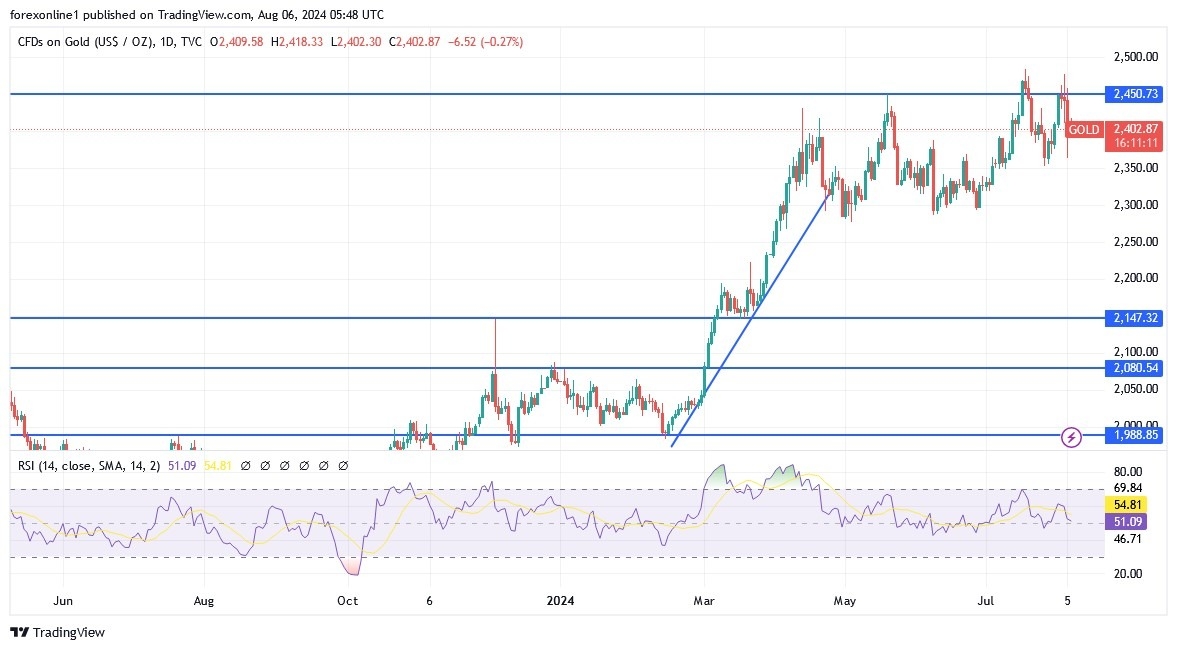- At the beginning of this week's trading, the price of gold fell to around $2,365 per ounce, paring its previous gains and retreating from last week's record highs as investors took profits.
- However, gold is benefiting from the safe-haven appeal as financial markets adopt a risk-averse stance.
- Thus, this explains the currency pair's rapid rebound towards the $2,412 per ounce resistance at the time of writing the analysis.

Fears about a recession in the United States have increased due to weak data and disappointing corporate earnings. On Friday, the US economy added a total of 114,000 jobs in July, which is less than the expectations of an increase of 175,000 jobs. In addition, the unemployment rate in the country unexpectedly rose to its highest level since 2021, and wage growth slowed more than expected. Moreover, this came on the heels of weak manufacturing data.
As a result, financial markets now see a greater than 70% chance of a 50-basis point rate cut by the Fed in September, pricing in around 155 basis points of total easing for this year and next. Also, Escalating tensions in the Middle East continue to support demand for safe-haven assets such as gold.
As for the factors affecting the gold market, US 10-year Treasury yield hits a 13-month low. According to the trade, the US 10-year Treasury yield fell around 3.70% on Monday, hitting its lowest level in more than a year amid bets that the Federal Reserve will cut interest rates more aggressively after a weak US jobs report raised concerns about a possible recession. Now, markets see a greater than 70% chance of a 50-basis point rate cut by the Fed in September, pricing in around 155 basis points of total easing for both this year and next.
Concurrently, investors are looking ahead to the US services PMI data and San Francisco Federal Reserve President Mary Daly’s speech for more insights.
Another factor affecting the gold market, the dollar, is at its lowest level in nearly 7 months. According to reliable trading platforms, the US dollar index DXY fell to 102.6 on Monday, its lowest level since mid-January, and extended its decline by about 1% last week, as weak economic data raised concerns about the resilience of the US economy and increased bets that the Federal Reserve will need to raise interest rates more frequently. Now, traders are pricing in about 115 basis points of rate cuts this year, with the probability of a 50-basis point cut in September at about 75%, compared to about 12% last week.
According to the results of the economic calendar, data showed on Friday that the US economy added 114,000 jobs in July, well below expectations of an increase of 175,000 jobs. Recently, the country’s unemployment rate unexpectedly jumped to a 2021 high of 4.3% and wage growth slowed more than expected. Earlier, the ISM Manufacturing PMI pointed to a surprise contraction in the manufacturing sector.
This week, the ISM Services PMI will provide an update on the performance of the services sector. The US dollar weakened the most against the yen and the Swiss franc.
Gold Price Forecast and Analysis Today:
As we always recommend buying gold from every downtrend, the gains returned to the direct trading recommendations from gold. Technically, we bought from the support level of $2369 per ounce and now the recommendations are reaping the gains. As we mentioned before, global geopolitical tensions will remain a fertile environment for the recovery of gold prices. Ultimately, stability above the psychological resistance of $2400 per ounce will remain a strong momentum for further bull control of the trend.
Ready to trade today’s Gold prediction? Here’s a list of some of the best XAU/USD brokers to check out.
